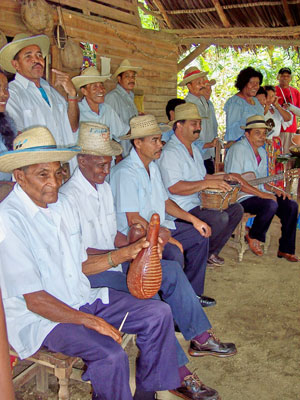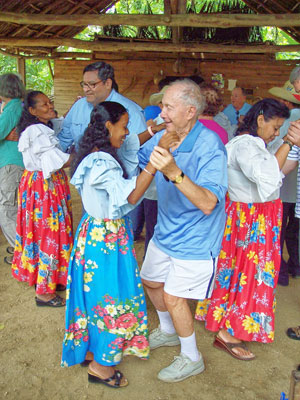Baracoa — lost in time, found in nature
This item appears on page 64 of the December 2013 issue.
(2nd of 3 parts on Cuba)
This pristine, nature-infused land of mystery was the eastern Cuba I had envisioned in planning my spring 2013 return visit to the long-forbidden island. The isolated Baracoa region was the focus of the second leg of my hosted journey with the Grand Circle Foundation. I was part of a small group of nine enthusiastic adventurers traveling under the US government’s “People to People” program.
We had just danced, often literally, through four exciting days and nights of varied cultural offerings in Havana. Now most of us were eagerly anticipating rural Cuba and the many unique cultural and natural-world attractions in and around Baracoa, our base for three nights in Guantanamo Province.
Baracoa, with its landmark El Yunque plateau (575 meters high) looming in the distance, was the first settlement, capital and diocese in Cuba, with origins dating to 1511. The town’s small, charming, well-preserved center reflects both French and neoclassical influences and was the focus of much of our exploration on foot. Thankfully, it was only a 5-minute walk from our hotel.
Lush tropical vegetation abounds in and around the city, in some cases seeming to invade the mostly older wooden buildings.
By chance, the annual Baracoa Carnaval was happening during our stay. The virtually nonstop, around-the-clock music and parading were thoughtfully relegated to the town’s waterfront esplanade, a strip well removed from the town center and our hotel.
This particular carnival was quite austere in appearance and left me feeling more sad than excited or culturally enlightened.
Nature abounds
The Cubans say “Baracoa means nature.” It seems true, as this long-isolated, unspoiled eastern region of the island contains the largest array of endemic flora and fauna both in Cuba and the whole of the Caribbean.
A large reserve near Baracoa, whose core is the UNESCO World Heritage Site designated as Alejandro de Humboldt National Park, has lush timber forest possessing an amazing variety of hardwood species. The region also features a most impressive system of eight scenic, clear rivers, crowned by the Toa, the largest river in Cuba.
The local economy has national influence and is based on coconut, cocoa and coffee production in addition to the extensive timber reserves. The region remains largely unknown to foreign visitors but, based on merit, has a developing presence as an ecotourism destination. Appealing guided walking treks and river expeditions are becoming increasingly available.
“People to People” takes center stage
We were in Baracoa, however, primarily for the purpose of getting to know the region through contact with its people. In this regard, we first visited Fuerte Matachín, a fortress completed in 1802 to protect the city from pirates and other marauders.
On arrival, we received a warm welcome, including being serenaded by a large gathering of locals. This was followed by a regional-history tutorial from Alejandro Hartman, historian and curator of the museum inside the fort. “Hartman,” as he is fondly known, is seemingly connected with everything that happens in Baracoa and was helpful with introductions throughout our stay.
Over three days, our activities included meeting with artists in their studios and at a gallery as well as taking a fascinating, instructional tour of a cacao farm.
One evening, we visited a paladar, a locally owned restaurant in a private home, where our poet host emotionally shared his thoughts about the opportunities and challenges of this type of private enterprise, something only recently allowed in his country.
On multiple occasions in the town center, many of us found relief from the searing heat at Casa del Cacao (123 Calle Maceo), famous for its hot chocolate but where our usual order was their ultrarefreshing chocolate ice cream with milk.
Our modestly appointed hotel, El Castillo (Baracoa’s best), was nestled on a hilltop above the town on the site of a former colonial fort. It featured commanding views of town, sea and forested hinterland stretching to distant El Yunque plateau and beyond. The inviting pool provided welcome respite after our long days of touring.
Fresh coconut, anyone?
Away from Baracoa on an unspoiled stretch of beach, we spent an enthralling morning with a fit 90-year-old coconut farmer and his fascinating 84-year-old shaman wife.
We learned how coconuts are transformed after harvest into a range of useful products, including cucurucho, a tasty candy in a husk cone. We had not expected a limber 90-year-old to scale a 25-foot tree barefoot to fetch a fresh coconut for our tasting, but, most amazingly, he did just that.
His wife also revealed some secrets of the shaman holistic healing powers she utilizes in ministering to the local community.
Chance encounters of the best kind
Feeling the urge to explore, I wandered away from the ageless couple’s modest beachfront residence to what appeared to be some type of happening a bit farther down the dirt road. I discovered three locals on the banks of a pristine river near its entrance into the sea. One was playing a guitar, and an older guy and young lady were dancing to the music.
Soon a few other locals began to arrive and I realized it was Sunday and, by all appearances, picnic and party day at the beach. It was perfect.
I retrieved the rest of our group, and we enjoyed an unplanned cultural encounter — including singing, dancing and wading in the river — in a true paradise setting. This type of instant happening was encouraged by our talented Cuban-American trip leader, Allan, a Havana resident, and such experiences punctuated our journey.
Later that day, during a riverside lunch stop, another group member and I decided to take a plunge. Immediately two young village boys, with no hesitation, decided the two new guys were just bigger kids and should be their diving springboards. We happily complied, and many back flips later we all had become fast playmates.
Such is the heartwarming openness of the wonderful rural Cubans, young and old.
Sing, play, dance, dine
One afternoon we ventured into the countryside to visit a small community that specializes in performing nengon and kiriba, two Afro-Cuban music styles, born locally, that have evolved into Cuba’s signature music, son.
Many of the performers were seniors. Under a thatch roof, the revelers undeterred by periodic showers, intoxicating rhythms prevailed. They played for us, they sang for us, they danced for and with us, we shared stories, and we broke bread in the form of a variety of unique and very tasty homemade dishes. Several offerings were laced with delicious crabmeat and other fresh seafood.
This was pure essence of Cuba — music, dance, cuisine and genuine communal sharing devoid of pretense. Best of all, it was beginning to feel normal.
Before you go…
For information concerning the “Cuba: Music, Culture & The Roots of Revolution” tour of Havana and eastern Cuba, contact Grand Circle Foundation (347 Congress St., Boston, MA 02210; 800/859-0852).
Keck's Beyond the Garden Wall
Why sit and talk about the life
when you can sing and dance to the life?
— Randy thinking “Cuban”


